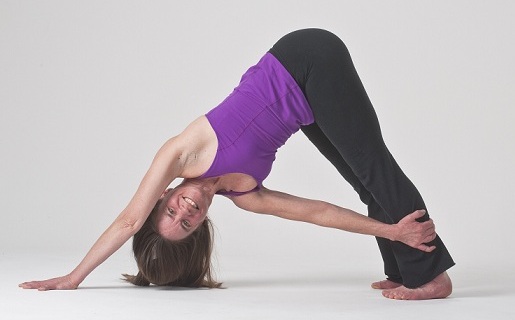
I received a suggestion/challenge from a student in one of my yoga classes recently: can we sometimes go to the left side first? She felt she was tighter on the left and that it seemed we spent more time on that first side.
I found this an interesting challenge because it would require me to practice what I teach on several levels.
On the physical level I often have students switch up how they clasp their hands behind their back, in order to balance things out. This is a little different, but the same principle operates: not giving preference to one way of doing it. I often use the hand clasping as an example of a certain mindlessness and habitual patterning we allow in our practice, and in our lives as a whole, and the same thing applies to switching up which side we move to first.
In our yoga practice, most times we just automatically do it. When the teacher says clasp your hands behind your back, my tendency is to put my right index finger on top of my left. Over time, this is going to have a subtle imbalancing effect on my shoulders. But as interesting is that choice moment when I act seemingly without thinking. I just do it automatically, as if there is no other choice. This happens in our yoga practice, and in many other domains of our life.
This is an example of a habit pattern. Notice how we don’t think about it, we reach with certain hands, turn certain directions. We have a repeated way we travel from point A to point B. We have “our” way of doing things, perhaps honed from our own trial and error to discover the “best” way of doing things.
Maybe, maybe not.
Or perhaps a teacher told us to do it that way. In the tradition in which I began doing yoga, we always moved to the right side first. Some might argue there is a physical or more esoteric advantage to this.
Maybe, maybe not.
I realized I had established a pattern that I was perpetuating, and chose to see what it was like to start shifting that pattern.
It was challenging. I was constantly flummoxed as I taught because after 25 years of teaching it one way I had grown lazy with my instructions. I didn’t have to think about it, I just did it. And now I had to be mindful.
I persevered. I announced to my students we were going to start moving left first in some classes. It became a bit of a game as they noticed and reminded me when I slipped into my old patterns. And they got to see their own patterns as I switched it up, and they were challenged to shift their own patterning. We giggled at ourselves together, and together we began to shift the pattern.
In summary, here’s the steps of how I worked with it:
– Notice the pattern. This is often the hardest part because it is so automatic. In this case, I was open to feedback. Someone sweetly mentioned a pattern that might not be altogether positive, and I listened. At first I was resistant, and I had to look at that and evaluate whether or not I wanted to shift.
– Set an intention. I made it public. I asked for help and accountability. I announced it to my classes so they could remind me. This allowed them as well to look at their own habits and resistance.
– Make a plan. I committed to starting on the left side first on the first and third weeks of the month. I made it concrete.
– Do it. Again. And again.
– Flounder. I allowed myself to flounder. I made mistakes. I allowed myself to not be perfect.
– Stop in your tracks when you are enacting the old pattern. Choose again the new pattern. When I became aware I was caught in the old pattern, I stopped and switched, right there in the moment. I didn’t wait to shift it until later. So my students have had to endure starting on one side, only to have me shift, but as I said, they were in on the game, and they’ve played along very sweetly.
– Understand it is a process. It is challenging. Allow it to be challenging
– Acknowledge success. I noticed how it became easier as I established the new pattern. With the switching the hands behind the back, it is hard now for me to discern that the new pattern feels weird.
Of course this is a somewhat trivial example in the larger scheme of habits in our lives we could benefit from shifting. But it makes the point. We all have patterns, some of which serve us, but others that may not. As we refine our lives we need to be mindful that we are making choices, and whether we are choosing the optimal choice. Our ability to pause and make conscious choices is one of the greatest gifts of our humanity. May we enact it.

